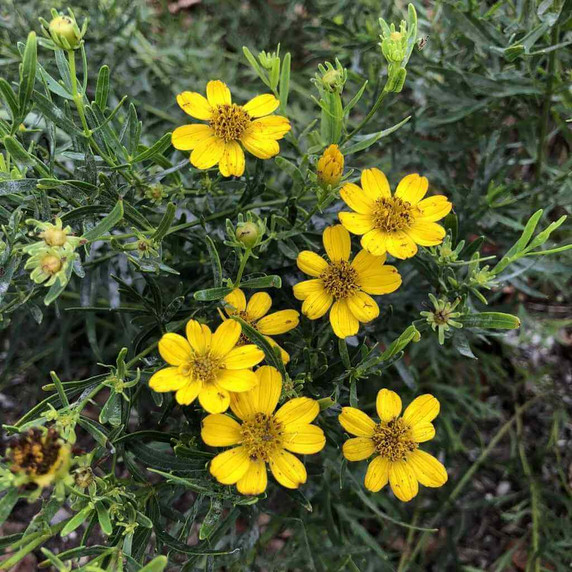Coreopsis palmata - PRAIRIE COREOPSIS
This modest and tough wildflower grows in ground-covering clumps that slowly spread by rhizomes, so in time and good conditions it can form some colonies (though it's not an aggressive spreader at all). 2" yellow flowers, dark green foliage. Coreopsis palmata starts flowering a little bit earlier than other Coreopsis species.
This coreopsis is not as showy as some others, but it has a good ground-covering habit, is a very long lived perennial, and is an excellent pollinator plant. Survives well in areas with poor, dry soils. Heat, humidity and drought tolerant plant.
Good for pollinator gardens, wildflower gardens, meadows, prairies and naturalistic plantings. Can be used as a matrix plant. It's generally underused in horticulture, but is a favorite plant of the great plantsman and naturalistic style designer Roy Diblik.
Also called Stiff Coreopsis or Stiff Tickseed.
Blooming Time: May to July
Size: 1.5-2.5' tall x 1.5-2' wide
USDA Zones: 3 to 8
Culture: full sun, half shade; average, rocky, and sandy soils
Moisture Needs: average to dry
Origin: native to the central USA and part of the Midwest (see the USDA distribution map)
Deer/Rabbit Resistant: yes / yes, may be browsed very occasionally
Attracts Butterflies or Pollinators: native bees (digger bees, cuckoo bees, leaf-cutting bees, Halictid bees, incl. green metallic bees, dagger bees), Sphecid wasps and other wasps, Syrphid flies, bee flies, thick-headed flies, Tachinid flies, bottle flies, Muscid flies, butterflies, skippers, moths, and beetles
Attracts Hummingbirds: no
Pot Size: square 3.5" x 4" deep perennial pot

Coreopsis palmata - PRAIRIE COREOPSIS
This modest and tough wildflower grows in ground-covering clumps that slowly spread by rhizomes, so in time and good conditions it can form some colonies (though it's not an aggressive spreader at all). 2" yellow flowers, dark green foliage. Coreopsis palmata starts flowering a little bit earlier than other Coreopsis species.
This coreopsis is not as showy as some others, but it has a good ground-covering habit, is a very long lived perennial, and is an excellent pollinator plant. Survives well in areas with poor, dry soils. Heat, humidity and drought tolerant plant.
Good for pollinator gardens, wildflower gardens, meadows, prairies and naturalistic plantings. Can be used as a matrix plant. It's generally underused in horticulture, but is a favorite plant of the great plantsman and naturalistic style designer Roy Diblik.
Also called Stiff Coreopsis or Stiff Tickseed.
Blooming Time: May to July
Size: 1.5-2.5' tall x 1.5-2' wide
USDA Zones: 3 to 8
Culture: full sun, half shade; average, rocky, and sandy soils
Moisture Needs: average to dry
Origin: native to the central USA and part of the Midwest (see the USDA distribution map)
Deer/Rabbit Resistant: yes / yes, may be browsed very occasionally
Attracts Butterflies or Pollinators: native bees (digger bees, cuckoo bees, leaf-cutting bees, Halictid bees, incl. green metallic bees, dagger bees), Sphecid wasps and other wasps, Syrphid flies, bee flies, thick-headed flies, Tachinid flies, bottle flies, Muscid flies, butterflies, skippers, moths, and beetles
Attracts Hummingbirds: no
Pot Size: square 3.5" x 4" deep perennial pot




